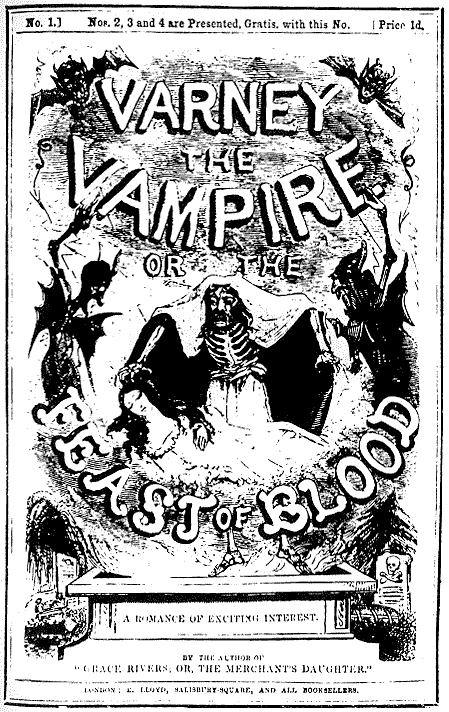Penny Dreadfuls
Regions: UK

The phrase “penny dreadfuls” arose amid the controversies that greeted the advent of mass-produced literature during the nineteenth century, denoting the weekly story-papers and penny-part novels aimed primarily at working-class readers. A variety of factors came together in the Victorian era to produce a flourishing market for inexpensive periodical literature. Rising wages and a shorter working week engendered a new culture of leisure among working people, who had more disposable income and more time in which to enjoy it. Rates of literacy among the laboring classes rose throughout the century, owing largely to the basic education provided by denominational schools prior to 1870, when the transformative Education Act created a network of Board Schools supported by local ratepayers, paving the way for compulsory education a decade later. The promise of a greatly expanded audience of young readers prompted Britain’s major publishers to expand into the field of juvenile literature, while the purveyors of the cheaper, ephemeral fare sold in weekly parts vied to earn their own fortunes one penny at a time. Advances in both printing and paper production aided their cause, enabling publishers to mass-produce their weekly issues at a minimal cost, while the expanding network of railways and the newsagents that flourished in and around the new railway stations provided an efficient distribution network.
The “penny” in “penny dreadful,” then, announces one key characteristic of these story-papers: they were the cheapest in the newsagents’ shops, within the means of those who could never afford the prohibitively expensive triple-decker novels or even the shilling installments in which most of Charles Dickens’s novels and many others were produced. A typical penny dreadful featured eight bound pages of text, embellished by an image designed to horrify, thrill, or otherwise fascinate readers. The judgmental note sounded by “dreadful” rang in response to the nature of the material on offer. The titles of some the earliest such publications—Legends of Horror (1825-26), for instance, or The Terrific Register (1825-27)—indicate the sensationalism that would define the penny dreadfuls throughout their history. One rich source of tales was the Gothic tradition, whose cellars were rife with gruesome thrills. Sweeney Todd, “the demon barber of Fleet Street,” is the best remembered of the Gothic creations to have originated in the penny dreadfuls, followed at some distance by James Malcolm Rymer’s Sir Francis Varney, whose adventures spanned 220 weekly chapters of Varney the Vampire (1845-47). Another vein was provided by The Newgate Calendar, an immensely popular assemblage of lurid stories detailing the histories of Britain’s most notorious criminals. Edward Viles’s Black Bess, or The Knight of the Road (1863-1865), whose popularity was sufficient to sustain a remarkable 254 weekly installments, was one of many penny dreadfuls to embellish and invent tales based on the life of the notorious eighteenth-century highwayman Dick Turpin. Another rogue transformed into a figure of romance was the thief and jail-breaker Jack Sheppard, whose journey from Tyburn to folk-legend began shortly after his execution in 1724. Robin Hood, the template for all of these latter-day romantic outlaws, was himself the subject of numerous penny-part novels throughout the century.
Penny papers for young readers were uncommon early on; however, their numbers—and the ensuing controversy—increased significantly with the more general growth in juvenile literature from the 1860s onwards. Edwin J. Brett’s weekly Boys of England journal was launched in 1866, immediately finding an eager, young, penny-brandishing audience: by 1870, Brett was selling 250,000 copies per week. Boys of England included advice to young boys and patriotic accounts of British history, but it was dominated by serial fiction, most notably the tales of Bracebridge Hemyng’s young adventurer, Jack Harkaway, one of the story-papers’ most treasured and successful characters. However, even the comparatively wholesome Jack Harkaway did not stem the criticism against the penny-papers. Their greatest failing in the eyes of their critics was that their producers aimed to thrill young readers rather than improve them. Accounts of historical criminals as romantic rogues prompted objections from a variety of journalists, clergymen and public officials, but so, too, did stories of truant schoolboys or runaway apprentices traveling to exotic locales and joining battle with pirates. Of particular concern was the appeal of these papers to working-class youths, deemed more likely—in the eyes of these anxious, middle-class onlookers—to be moved to a dangerous unruliness inspired by the feats of their fictional heroes.
One strategy adopted by the critics was to produce more palatable alternatives. The most noteworthy of these was The Boys’ Own Paper, founded by the Religious Tract Society in 1879. Both edifying and entertaining, The Boys’ Own Paper quickly established itself as the most popular of all the Victorian boys’ periodicals and was followed in 1880 by a companion Girls’ Own Paper, one of the few weekly papers produced explicitly for a female readership. More dubiously, The Daily Mail publisher Alfred Harmsworth declared war on the penny dreadfuls when he moved into the juvenile market in the 1890s. The similarity of Harmsworth’s offerings to those already in circulation suggests that his campaign was more focused on pennies than dreadfulness. Nonetheless, he forced most of his smaller competitors out of business by halving their already low prices. By the end of the century, the controversy had dwindled, with much of the sensationalism that had been so troubling in earlier decades now channelled in the supposedly more wholesome direction of imperial adventure favoured by Boys’ Own and Harmsworth alike. Harmsworth’s domination of the market was ended in the 1920s by the arrival of the Dundee-based publisher D.C. Thompson, some of whose boys’ story papers, such as The Rover, The Hotspur and The Wizard, would carry residual traces of the sensationalistic penny dreadfuls deep into the twentieth century.
— Brian Patton
Further Reading
- Carpenter, Kevin. Penny Dreadfuls and Comics: English Periodicals for Children from Victorian Times to the Present Day. : Victoria and Albert Museum, 1983.
- Haining, Peter, ed. The Penny Dreadful, or, Strange, Horrid & Sensational Tales! London: Victor Gollancz, 1976.
- Richards, Jeffrey, ed. Imperialism and Juvenile Literature. Manchester & New York: Manchester University Press, 1989.


